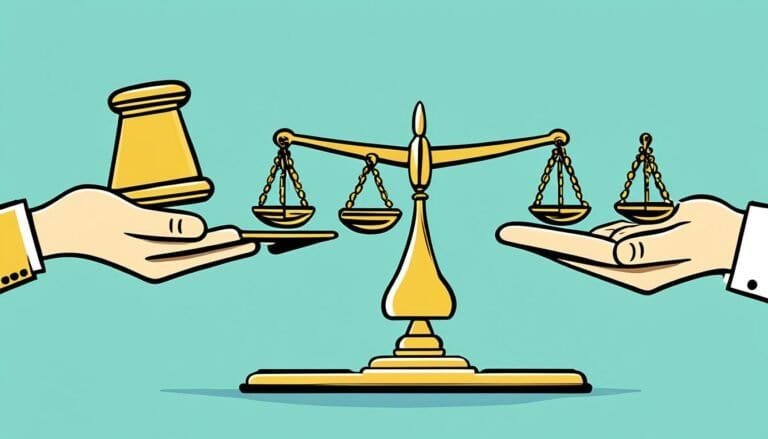Conflict Resolution in Healthcare Environments
“The greatest weapon against stress is our ability to choose one thought over another.” —William James
Conflict in healthcare is common due to the stressful work. Misunderstandings, different personalities, and fights over resources often cause disagreements. These issues can hurt patient care, team work, and morale.
Effective conflict resolution is key in healthcare. It’s not just good to have, it’s necessary. This is because conflicts can directly affect how well patients do.
Managing conflicts well can turn a tough work place into a team effort. Emotional smarts are now seen as vital. They help create a positive work environment.
Key Takeaways
- Conflict resolution in healthcare environments significantly impacts patient care and safety.
- Disputes can arise from communication barriers, personality clashes, and resource allocation.
- High emotional intelligence among healthcare staff is crucial for effective dispute resolution.
- Structured interventions and professional codes of conduct improve team dynamics and morale.
- Implementing conflict resolution strategies helps avoid legal and ethical complications.
The Importance of Conflict Resolution in Healthcare
In healthcare, solving conflicts is crucial. If not handled, issues like communication problems, disagreements over resources, and personal differences can harm patient safety. They can also make staff less happy and less efficient. Knowing how to solve conflicts well is key to a healthy work place and good patient care.
Impact on Patient Care
Good conflict resolution is essential for top-notch patient care. Stress can make it hard to read body language, listen well, and share needs clearly. This is vital in healthcare. In fact, 70% of mistakes that could be prevented are because of poor communication and teamwork.
When conflicts are solved well, communication gets clearer and performance improves. This leads to happier patients and better HCAHPS ratings.
Team Dynamics and Morale
Handling conflicts in healthcare affects how teams work together and how happy they are. Staff often see doctors as the main cause of conflict, which can make work hard if not fixed. Conflicts can be good, making teams work better together and perform better when solved right.
But if conflicts are not solved, they can make work harder, lead to more staff leaving, and lower morale. Having a good way to solve conflicts keeps the workplace positive.
Legal and Ethical Implications
Dealing with conflicts is important for better patient care and team work. The law now makes it key to handle a bad work environment well. Healthcare places must have strong ways to solve conflicts.
Handling conflicts ethically is key to keeping care standards high and making a safe, respectful place for patients and staff. The process of solving healthcare conflicts must be careful and proactive. This helps avoid legal issues and follows ethical rules.
Common Causes of Conflict in Healthcare Settings
Conflicts in healthcare are common and come from many sources. It’s key to tackle these issues to keep the work environment positive and patient care top-notch.
Communication Barriers
Communication problems are a big cause of conflict in healthcare. Poor communication can lead to mistakes and misunderstandings. For example, in a Greek pediatric hospital, how staff communicated and managed conflicts affected their job happiness.
Using clear and regular communication can help solve these problems.
Personality Clashes
Healthcare workers with different personalities can clash. In Saudi Arabian hospitals, nurses used various ways to solve conflicts caused by these differences. These clashes can make it hard to work together, which is crucial in stressful places like emergency rooms.
Using mediation and team-building can help with these issues.
Resource Allocation
Not having enough resources is another big conflict cause in healthcare. A study in Sweden showed that nurses faced more work-family conflict due to limited resources. When specialists and teams fight over what’s available, it can lead to frustration and low morale.
Using strategies like clear decision-making and sharing resources fairly can help ease these tensions.
About 15% of healthcare conflicts come from specialist rivalries, limited resources, changes, and poor communication. By understanding these causes and using good conflict management, healthcare can lessen conflicts and their effects.
Healthcare Conflict Resolution Strategies
Conflict resolution is key in healthcare to ensure quality care and team harmony. Using effective techniques can cut down on misunderstandings and boost communication among healthcare workers.
Mediation and Facilitation
Mediation and facilitation are vital for solving healthcare conflicts. A neutral person helps in leading talks, making sure everyone gets to share their thoughts. This leads to solutions that everyone can agree on.
Research in 2008 by Behfar et al. showed how important conflict resolution is in healthcare teams. Healthcare workers can use tools like the Thomas-Kilmann Conflict Mode Instrument (TKI) to handle conflicts well. These tools help deal with conflicts from personal differences, lack of information, and different roles.
Open Communication Channels
Keeping communication open is key to preventing misunderstandings and smooth operations in healthcare. A study in the British Medical Journal in 2016 found that most medical mistakes come from poor communication and teamwork. Skills like active listening, finding common ground, and respectful dialogue are key in conflict resolution training.
The COVID-19 pandemic highlighted the need for conflict resolution in healthcare. Open, professional communication helps reduce conflicts, improving team unity and patient care.
Effective Conflict Resolution Techniques
Using effective conflict resolution techniques is key to keeping healthcare teams in harmony. Techniques like structured mediation, active listening, and open communication are vital. They help solve conflicts quickly and effectively, creating a team environment focused on quality care.
Active Listening
Active listening is a key skill in resolving conflicts. It means fully paying attention, understanding, and responding to what others say. This helps healthcare workers get to the heart of conflicts, which often stem from poor communication and teamwork (British Medical Journal, 2016).
Empathy and Understanding
Empathy and understanding are key in solving conflicts. By seeing things from another’s point of view, healthcare workers can tackle the human side of disputes (Behfar et al., 2008). This method lowers the chance of things getting worse and makes sure solutions respect everyone involved.
Problem-Solving Approaches
Problem-solving is crucial in resolving healthcare disputes. The Thomas-Kilmann Conflict Mode Instrument (TKI) shows different ways to handle conflicts, like collaborating or compromising (Thomas & Kilmann, 1974). Collaborative problem-solving brings teams together to find solutions that benefit everyone, enhancing teamwork and patient care.
In summary, learning these conflict resolution techniques is essential for healthcare. By using active listening, empathy, and effective problem-solving, healthcare workers can create a peaceful and efficient work environment.
Training Programs for Conflict Resolution
In healthcare, managing conflicts well is key for top-notch patient care and teamwork. Specialized training programs help healthcare workers learn how to handle and solve conflicts. This helps both the staff and the patients.
Workshops and Seminars
Workshops and seminars are big parts of learning to manage conflicts in healthcare. These sessions offer hands-on learning and real-world insights. They last for four weeks, with live sessions on Zoom for about 90 minutes each.
Sanne Henninger, EdD, LCSW, from Duke Private Diagnostic Clinics, leads one program. It focuses on emotional smarts, stopping conflicts, and helping individuals and teams. The cost is $500 per person, with discounts for teams. Participants spend about 120 minutes a week on the training.
Role-Playing Scenarios
Role-playing is a big part of learning to manage conflicts in healthcare. It lets workers practice their skills in a safe setting. By acting out real conflicts, they get ready to tackle actual ones with confidence.
Through role-playing, workers learn to spot and solve different kinds of conflicts. This helps them use the right strategies in real healthcare situations. It makes sure providers can deal with disputes well, which helps patients and boosts team spirit.
Long-Term Benefits
Conflict resolution training in healthcare has big long-term benefits. It boosts communication, teamwork, and decision-making skills. This means better care for patients and more satisfaction for everyone.
It also makes the workplace more positive, which makes nurses less stressed. This leads to better work efficiency and outcomes, making healthcare better for everyone.
Challenges in Implementing Conflict Resolution
Trying to solve conflicts in healthcare settings is tough. It’s key to know the problems and plan well.
Resistance to Change
Healthcare workers often resist new ways of solving conflicts. They like their old routines and find it hard to change. This can be due to not understanding the new methods, fear of the unknown, or thinking the current way is good enough.
To overcome this, we need strong training, clear talks, and showing how solving conflicts helps everyone.
Cultural Barriers
Different cultures bring different views and ways of talking, making it hard to solve conflicts. We need to accept these differences and use strategies that respect everyone’s culture. This makes healthcare more welcoming for everyone.
Case Studies: Successful Conflict Resolution in Healthcare
Looking at how to solve conflicts in healthcare can be really helpful, especially with real examples. Many *healthcare conflict management case studies* show that the right strategies can fix disputes and make teams work better together. This also helps improve how we care for patients.
In an observational study, conflicts in operating rooms were seen as stressful events. These stressful situations need good conflict solving to keep patient care high. On average, teams in the operating room faced about four conflicts per surgery.
By using structured debriefings after surgery, many teams felt less tension and worked better together.
A study found that 91% of nurses faced verbal abuse. One nursing unit started a peer-mediation program. This led to fewer cases of verbal abuse. The program helped nurses talk openly and solve conflicts early.
A survey of 5,000 full-time employees in nine countries showed that 85% dealt with conflict at work. 29% faced it often or always. By using *healthcare conflict management case studies* and training in emotionally intelligent communication, these organizations got better morale and teamwork.
An IT group in a hospital saw a 30% better quality, almost 40% more productivity, and nearly 50% less cost by improving their communication. These examples show how solving conflicts early and with clear strategies can make a big difference.
When conflicts between people at the same level affected how quickly and well patients were cared for, *healthcare conflict management case studies* found that working together to solve problems helped. A hospital started conflict resolution training and saw better patient care because of better teamwork and communication.
Rising Violence in Healthcare: Prevention and Management
Violence in healthcare settings is a growing concern. It affects the safety and well-being of healthcare workers. In 2018, healthcare workers faced 73% of all nonfatal workplace injuries and illnesses from violence, says the U.S. Bureau of Labor Statistics. This trend calls for strong strategies to prevent violence in healthcare and manage it well.
Recognizing Warning Signs
It’s crucial to spot signs of potential violence early to prevent it from getting worse. Signs include verbal abuse, aggressive body language, and threats. In 2018, verbal abuse was behind 61.2% of workplace violence incidents in healthcare. Threats were in 39.5% of cases. Training staff to recognize and act on these signs helps prevent violence and solve disputes in healthcare.
Creating Safe Work Environments
Creating a safe work environment means using many security steps and preventive actions. It’s important to control who can enter healthcare facilities, regularly check security, and have clear plans for violent situations. In Malaysia, introducing guidelines and training led to a 159% increase in reported violence against healthcare workers. This shows how important structured actions are.
Also, having a no-tolerance policy for violence, as the American Nurses Association suggests, helps protect healthcare staff. Overall, preventing violence in healthcare needs careful attention to warning signs and secure environments. By focusing on safety, healthcare organizations can manage violence better and protect their workers.
Source Links
- Conflict in the health care workplace
- Conflict Resolution for the Healthcare Industry
- Conflict resolution styles and skills and variation among medical students – BMC Medical Education
- How to Promote Healthy Conflict Resolution in Healthcare
- Strategies for Resolving Conflict to Enhance Patient Care and Fostering a Positive Work Environment
- Conflict In Nursing: Types, Strategies, and Resolutions – Trusted Health
- Causes of conflict between clinical and administrative staff in hospitals
- Examples of Conflict in Healthcare Setting + Conflict Resolution Strategies
- Resolving conflict between healthcare providers
- Navigating Challenges: Healthcare Workplace Conflict Resolution – The Kensington White Plains
- Navigating Challenges: Healthcare Workplace Conflict Resolution – The Kensington Reston
- Conflict Resolution Training for Nurses | AllWin Conflict Resolution Training
- Conflict Resolution Training for Healthcare Professionals| Peaceful Leaders Academy
- Managing Conflict in Health Care (Virtual)| Team Training | Center | AHA
- 5.2 Conflict Management
- Top Conflict Management Approaches in Healthcare
- Managing Conflict in Health and Social Care: Guidance on Recognising and Handling Confrontations
- Conflict Management: Difficult Conversations with Difficult People
- When Team Conflicts Threaten Quality of Care: A Study of Health Care Professionals’ Experiences and Perceptions
- Conflict Management and Resolution as a Resident | NEJM Resident 360
- Workplace violence in healthcare settings: The risk factors, implications and collaborative preventive measures
- Violence against nurses by patients and visitors in the emergency department: A concept analysis







